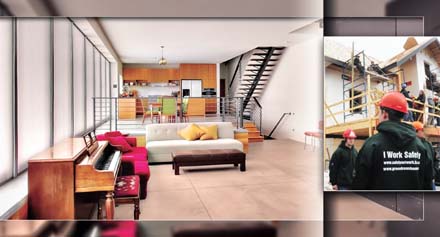Other

GOING GREEN: B.C. workers trained in BuiltGreen procedures complete a green demonstration house in Kamloops; a green house interior shows open space design, non-offgassing materials recommended by CMHC. Photo: CHBA-BC / ChicTip
The federal government has reinstated funding for green home renovations, the provincial government also offers rebates for such work and the City of Vancouver recently approved a one year pilot program to offer 500 city homeowners low-interest loans for energy efficiency retrofits with payments tied to their property taxes. And, according to a recent survey by Bank of Montreal, nearly half of Canadians plan to make energy efficient home upgrades this year. When it comes to why they’re making upgrades, 19 per cent said they wanted to improve their quality of life, while 75 per cent said making the effort to be environmentally conscious makes them feel happier. As well, 89 per cent said they would pay more for energy efficient features if there were evidence it would reduce energy costs. But what makes a home, either new or renovated, a green home? According to Canada Mortgage and Housing, the following are basic green features as outlined in its Equilibrium home projects: – An accessible and attractive open-plan concept: – Locally-produced and environmentally-appropriate building materials, to reduce pollution and enhance indoor air quality: – Energy-efficient lighting and appliances designed to reduce energy consumption by up to 17 per cent; – Water conservation features and fixtures, such as low-flow toilets, that reduces water use; – High-efficiency heating systems: – An air-tight, high-performance building envelope to provide a comfortable living environment; – High-efficiency windows and doors that reduce heat loss: and – The use of paints and sealants that do not produce harmful gases. Green options include passive solar heating and/or a solar collector system that helps heat space or domestic hot water. In renovation project, green features start with handling construction waste, looking first to recycling options to divert materials from landfills. Typical rent would cover a mortgage Rising rents in B.C. mean that, with today’s low mortgage rates, most tenants could probably swing a mortgage for the same cost. The average rent for a Vancouver two-bedroom apartment is now $1,181 per month, the highest in the country, while Abbotsford is at $797, for example. For that monthly payment, many tenants could purchase a condo apartment and enjoy the benefits and equity of homeownership. The apartment rental vacancy rate in British Columbia has increased to 3.7 per cent, compared to 3.1 per cent a year ago, according to a spring survey from Canada Mortgage and Housing Corporation (CMHC.) In Vancouver, the vacancy rate is now 2.8 per cent, up from 2.2 per cent, while the vacancy rate in Abbotsford is unchanged at 6.6 per cent. Copyright Real Estate Weekly

